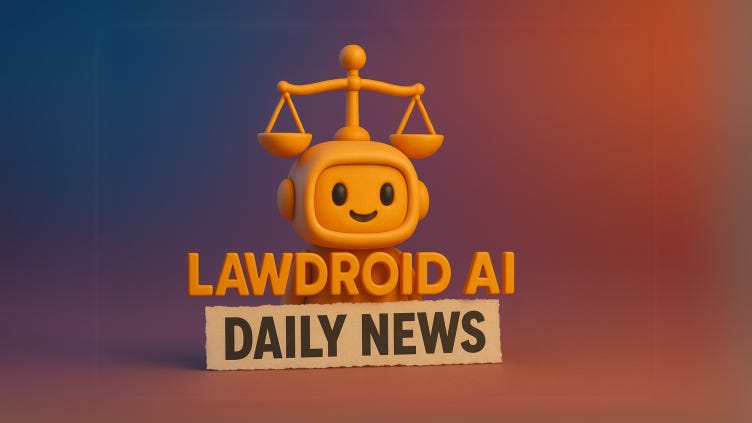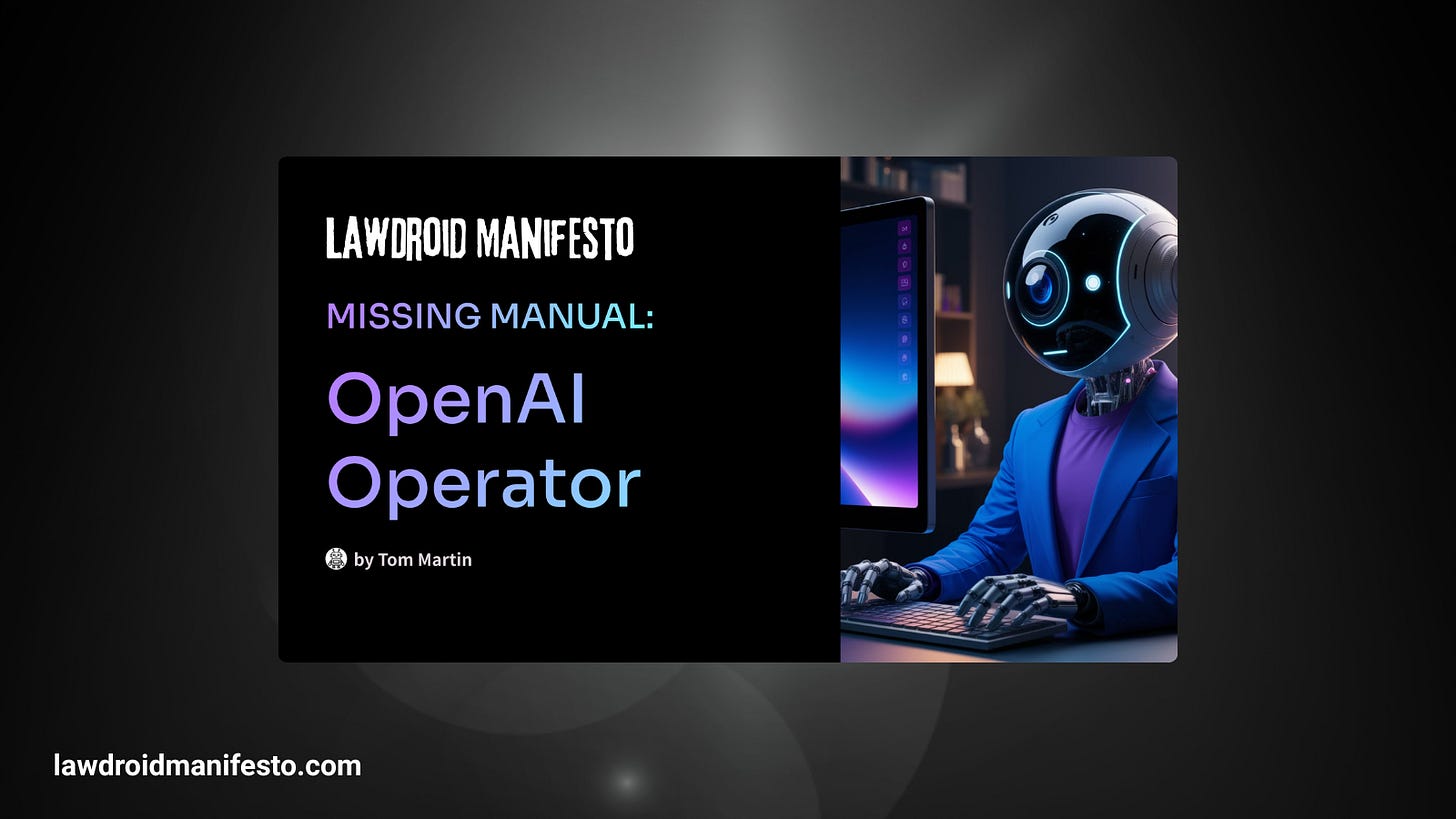Daily News: April 25, 2025
AI news that pops: daily insights, fast takes, and the future right in your inbox
Hey there friends👋! In today’s edition, you’re getting 5 🆕 news item and my take on what it all means. That’s it — delivered to your inbox, daily.
Subscribe to LawDroid Manifesto and don’t miss tomorrow’s edition:
LawDroid AI Daily News, is here to keep you up to date on the latest news items and analysis about where AI is going, from a local and global perspective. Please share this edition with your friends and colleagues and remember to tell me what you think in the comments below.
[NOTE: Apologies, this is a late post of Friday's news; Also, while I have you here, I will be changing the schedule to publish the weekly edition on Sunday.]
Today’s News
Here are the top 5 recent news items on artificial intelligence:
1. AI Won’t Replace Doctors; It Will Upgrade Them
AI is already having a measurable impact in healthcare, particularly in emergency and radiology departments. At Ochsner Health in Louisiana, AI immediately alerts care teams when it detects critical conditions such as strokes or brain bleeds, significantly reducing response times where every minute delay can cost patients nearly two million brain cells. In radiology, AI has lowered diagnostic miss rates, which can reach up to 20% in emergency settings, by highlighting subtle fractures and lung nodules that might otherwise be overlooked. Additionally, AI can integrate fragmented patient records, enabling earlier detection of serious conditions such as heart failure, ensuring clinicians have the comprehensive information they need to make timely decisions and improve patient outcomes.
Source: https://thehill.com/opinion/healthcare/5267466-ai-replacing-doctors-future/
2. Fans are Using AI to Predict F1 Race Winners, with Impressive Accuracy
Data scientist Mariana Antaya has created an AI-powered model that successfully predicted three Formula 1 race winners this season. Her machine learning tool uses data including previous lap times, qualifying performances, team performance trends, and even weather conditions to forecast outcomes. Initially developed as a fun exercise, the AI has accurately predicted victories by analyzing information from the FastF1 API, and now incorporates crowdsourced suggestions to improve accuracy, such as wet-weather performance and team progress throughout the season. As Antaya continues refining her model with new data and more sophisticated algorithms, her predictions are becoming increasingly precise, although she notes the inherent unpredictability of events such as crashes and safety cars in F1 races.
3. Google’s Huge Cost Advantage in AI Battle With OpenAI
Google’s decade-long investment in custom Tensor Processing Units (TPUs) gives it an 80% cost advantage in running AI models compared to OpenAI’s reliance on expensive Nvidia GPUs, according to recent analysis. While both companies offer similar generative AI capabilities, Google’s cheaper hardware allows significantly lower API prices, potentially positioning it as the more affordable, scalable enterprise choice. Meanwhile, OpenAI maintains a strong market presence through its tight integration within Microsoft’s widespread Azure and Microsoft 365 ecosystems, emphasizing powerful agent-based reasoning despite higher costs and reliability risks.
Source: https://venturebeat.com/ai/the-new-ai-calculus-googles-80-cost-edge-vs-openais-ecosystem/
4. Prompt Engineering, Once a Hot AI Job, Quickly Goes Obsolete
Prompt engineering, once a high-demand, lucrative job fetching salaries up to $200,000, has quickly become obsolete due to rapid advancements in AI technology. Improved large language models now better intuit user intent, reducing the need for precise input crafting. Companies have also broadly trained employees across roles, making specialized prompt engineers unnecessary. AI systems today can ask clarifying questions, interact conversationally, and adapt to context on their own. Thus, prompt engineering’s rise and fall exemplifies how swiftly AI’s evolution reshapes tech job markets.
Source: https://www.wsj.com/articles/the-hottest-ai-job-of-2023-is-already-obsolete-1961b054
5. U.S. Government Warns of AI’s Environmental and Human Risks, Calls for Urgent Research
The nonpartisan Government Accountability Office (GAO) has raised significant alarms about generative AI, highlighting concerns over its substantial environmental impact, including high energy consumption, carbon emissions, and water usage, as well as its societal and security risks, such as job displacement, misinformation, privacy violations, and biased systems. The GAO emphasized that AI developers’ lack of transparency severely hinders research into these impacts, leaving policymakers ill-equipped to understand or manage long-term consequences. Despite these concerns, the Trump administration, aligned closely with prominent AI proponents Elon Musk and Sam Altman, continues to aggressively pursue AI adoption in federal programs while scaling back previous oversight commitments.
Source: https://mashable.com/article/generative-ai-environment-impact-us-government
Today’s Takeaway
Today's news demonstrate the incredible potential and profound complexity of AI’s integration into society. I find the healthcare advancements genuinely inspiring, showcasing AI’s ability to meaningfully enhance human abilities rather than replace them. The success of AI in predicting F1 races highlights how data-driven insights can redefine industries, yet it also hints at a future of relentless optimization where spontaneity and surprise might fade. Google’s massive cost advantage points toward a troubling concentration of power among a few tech giants, raising legitimate concerns about competition, innovation, and fairness. Meanwhile, the rapid obsolescence of jobs like prompt engineering underscores how swiftly AI reshapes the employment landscape, demanding continuous adaptation from workers. Most critically, the GAO’s warning resonates deeply: AI’s unchecked growth poses significant environmental and societal risks, urgently demanding responsible governance, ethical standards, and thoughtful regulation. These headlines collectively suggest we’re at a defining crossroads, where harnessing AI’s enormous promise requires vigilant oversight and intentional action to avoid unintended harm.
Subscribe to LawDroid Manifesto
LawDroid Manifesto, your authentic source for analysis and news for your legal AI journey. Insightful articles and personal interviews of innovators at the intersection of AI and the law. Best of all, it’s free!
Subscribe today:
By the way, as a LawDroid Manifesto premium subscriber, you would get access to exclusive toolkits, like the Missing Manual: OpenAI Operator, coming out this month…
With these premium toolkits, you not only learn about the latest AI innovations and news items, but you get the playbook for how to use them to your advantage.
If you want to be at the front of the line to get first access to helpful guides like this, and have the inside track to use AI as a force multiplier in your work, upgrade to become a premium LawDroid Manifesto subscriber today!
I look forward to seeing you on the inside. ;)
Cheers,
Tom Martin
CEO and Founder, LawDroid




